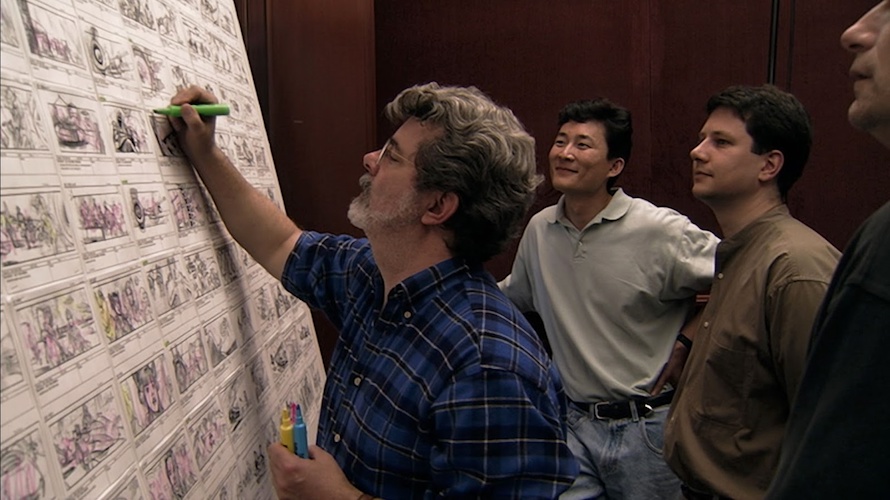TV Review: ILM Pioneers the Digital Effects Revolution in the Beyond-Fascinating Second Season of "Light & Magic"
A few years ago Disney+ subscribers were treated to the wonderful six-episode first season of the Lawrence Kasdan-directed docuseries Light & Magic, which chronicled the formation and early years of Lucasfilm’s in-house visual effects studio Industrial Light & Magic, up to its involvement with the Star Wars prequel trilogy in the late 1990s and early 2000s. Now filmmaker (and former ILM effects artist) Joe Johnston (The Rocketeer, Jumanji) has stepped in to deliver a three-episode second season of Light & Magic, and below are my thoughts.
Overlapping with and picking up right around where Kasdan left off, Johnston’s season zooms in on the period between the early-1990s digital innovation of Jurassic Park and the mid-aughts, with the completion of the Star Wars prequels. The emphasis of Light & Magic season 2 is on how CGI visual effects and digital filmmaking in general revolutionized the movie industry, but Johnston also wants to make sure the people who pioneered that work are at the front and center of his documentary. Here we get to know designer and concept artist Doug Chiang, effects supervisor (and co-creator of PhotoShop who George Lucas himself calls a genius) John Knoll, animation director Rob Coleman, and effects animator Hal Hickel, among others, in addition to spending more time with ILM mainstays like Dennis Muren. The season concludes with the bittersweet shuttering of the studio’s physical model shop in San Rafael, which operated for decades in the wake of the original Star Wars trilogy, but the thrust of this remembrance is how ILM got there.
We hear about when Lucas watched ILM’s work on the 1996 fantasy film Dragonheart and decided that the company was ready to tackle the prequels, and then the documentary goes into absolutely fascinating detail about the challenges the effects artists faced in bringing Episodes I through III to life on the big screen. In-between the extended analyses of Star Wars VFX, we also learn about the efforts that went into director Jan de Bont’s Twister in 1996 (this required advancements in particle simulation), Wolfgang Peterson’s The Perfect Storm in 2000 (which helped ILM push the envelope on re-creating water in CGI), and Gore Verbinski’s Pirates of the Caribbean trilogy (in which ILM’s artists one-upped Weta Digital’s Gollum by creating the jaw-dropping motion-captured character of Davy Jones. And speaking of memorable motion-capture performances, Light & Magic season 2 devotes a decent chunk of its running time to telling the story of actor Ahmed Best’s contributions to the controversial Jar Jar Binks, which he inhabited both on set and on a soundstage decked out in plastic reflective marker balls. The emotional low point of the documentary comes when Best recalls his near-attempted suicide after fans’ response to Jar Jar, but that comes across as tangential in a history of a VFX house. As George Lucas even says in a newly recorded interview here, fans’ reaction to the character had very little to do with ILM’s work. Best’s tribulations are an important part of the behind-the-scenes Star Wars narrative, but I’m not sure that Light & Magic was the most appropriate vehicle for them.
That said, the bulk of Light & Magic season 2 is engrossing is much the same way that the first batch of episodes was– I learned an awful lot about how the visual effects business evolved over that timeframe and was glad to hear from so many of the players involved, including prequel trilogy producer Rick McCallum, who surprisingly had a semi-contentious relationship with ILM in his goals to slash the budgets on those movies. Much like how fan regard for the prequels has warmed up considerably in the time since their release, I guess it takes about a quarter-century to get significantly more transparency on their various backstage woes. I also thought the third-episode segment about Steven Spielberg’s War of the Worlds (which Muren calls his favorite movie that he's contributed to) particularly compelling, along with a segment recounting the making of ILM’s first fully animated feature film– Verbinski’s Rango– which I now find myself itching to revisit, knowing what went into its creation. Interestingly, Johnston leaves the window open at the end of his trilogy of chapters for more of ILM’s story to be told, in that he barely touches on the topic of the studio’s innovations in the realm of virtual production with its StageCraft technology and the inventive LED soundstage known as The Volume. And despite Disney+ having already explored that territory in its Disney Gallery: The Mandalorian docuseries, I suspect a third (and perhaps final) season of Light & Magic may be on its way sooner or later, in order to truly bring audiences into the modern era of visual effects.
Light & Magic season 2 debuts in its entirety tomorrow, Friday April 18th, exclusively via Disney+..
More on Light & Magic:




